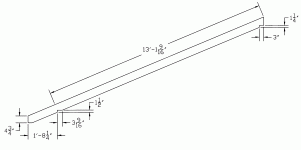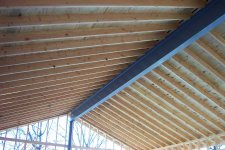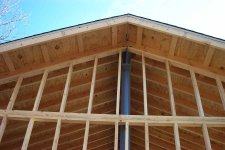radair
Gold Member
<font color="blue">
Are you concerned with the notch on the tension side of the rafter?
No, it’s standard practice to notch the tail end. What’s the difference if one or both ends get notched? Most of the tension (bottom side) and compression (top side) occurs out in the middle, not at the ends. </font>
The difference is the tail end has full bearing on the wall plate, so the notch (bird's mouth) does not change the load carrying cross-sectional area of the rafter.
The detail you have at the ridge reduces the x-section to the thickness measured from the notch. While tension due to bending moment is greatest in the middle of the rafter, shear is greatest at the ends. This is not a good detail. Maybe you have no significant snow loads to be concerned with, but I would never recommend it.
Are you concerned with the notch on the tension side of the rafter?
No, it’s standard practice to notch the tail end. What’s the difference if one or both ends get notched? Most of the tension (bottom side) and compression (top side) occurs out in the middle, not at the ends. </font>
The difference is the tail end has full bearing on the wall plate, so the notch (bird's mouth) does not change the load carrying cross-sectional area of the rafter.
The detail you have at the ridge reduces the x-section to the thickness measured from the notch. While tension due to bending moment is greatest in the middle of the rafter, shear is greatest at the ends. This is not a good detail. Maybe you have no significant snow loads to be concerned with, but I would never recommend it.





